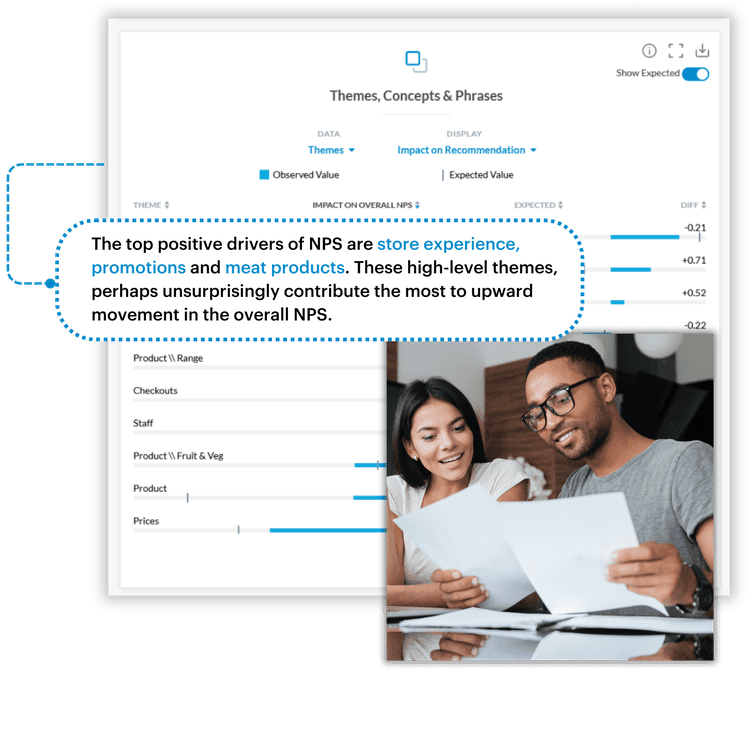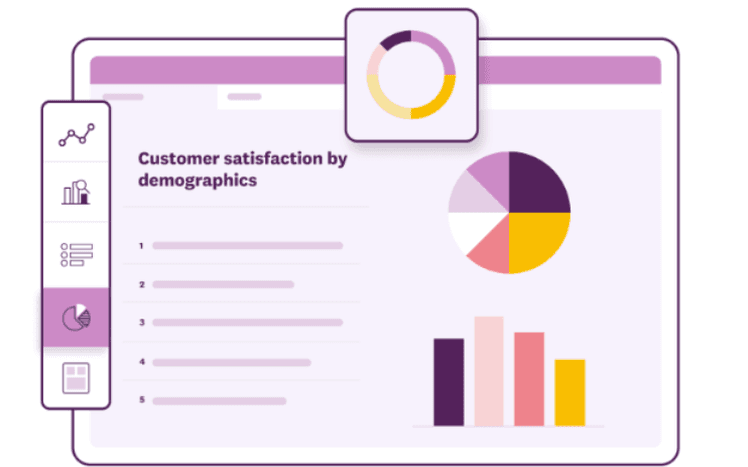Understanding and leveraging customer feedback is a major key to success in any market.
If you’re an Insights lead, your mission likely revolves around improving customer experiences, and getting data on how to refine products and services.
One of the most powerful ways to do this on the regular, is by having an effective customer feedback analysis process in place. This article serves as a customer feedback analysis guide to help you understand and improve your customer feedback over time.
In this article, we’re going to walk through step by step how you can do great customer feedback analysis, the elements involved, and top tools that can help you.
Let’s dive in.
What is Customer Feedback Analysis
Customer feedback analysis is the systematic process of examining and interpreting feedback from customers across various touch points.
It involves collating feedback data from multiple sources like surveys, reviews, support tickets, and social media, then categorizing and analyzing the feedback to uncover insights using various customer feedback analysis methods. These methods range from manual analysis to more sophisticated approaches like automated tools, AI-powered analysis, sentiment analysis, and NLP, each offering unique insights to drive strategic decision-making and improve overall customer experiences. Let’s delve deeper into the key aspects of customer feedback analysis:
Why Customer Feedback Analysis Matters
Customer feedback analysis goes beyond skimming through reviews and survey responses.
It lets you dive deep into understanding your customers' preferences, pain points, and aspirations. Getting your analysis process right is key to uncovering actionable insights that can steer your company in the right direction.
Here are some of the ways that regularly analyzing customer feedback can benefit your team:
Data-Driven Decision Making: By analyzing customer feedback, your team can make informed decisions based on real customer experiences, rather than assumptions or guesswork.
Continuous Improvement: Feedback analysis highlights areas for improvement in products, services, processes, and customer interactions, fostering continuous growth and innovation.
Customer-Centricity: Understanding customer sentiment no and preferences enables organizations to tailor offerings to meet customer needs effectively, enhancing satisfaction and loyalty.
Competitive Advantage: Leveraging insights from feedback analysis allows businesses to stay ahead of competitors by addressing issues proactively and delivering exceptional experiences.

Customer Feedback Collection Methods
To effectively collect feedback and enhance your customer experience, it's crucial to gather customer feedback from various sources such as email, SMS, review websites, in-app, on-site, and social media. The more diverse, the better. Here are some of the best sources to collect customer feedback data from, to support your analysis.
Surveys: Structured questionnaires designed to gather specific feedback on product features, customer service interactions, overall satisfaction, and more.
Reviews and Ratings: Monitoring and analyzing customer reviews on platforms like Yelp, Google Reviews, or industry-specific review sites.
Social Media Listening: Using social listening tools to track mentions, sentiment, and trends related to your brand or industry on social media platforms.
Customer Support Interactions: Analyzing data from customer support tickets, live chats, and emails to identify recurring issues and areas for improvement.
Feedback Forms: Implementing feedback forms on websites, mobile apps, or after specific interactions to capture immediate feedback.
Qualitative vs. Quantitative Analysis
Ideally, you'll want to aim for a blend of both qualitative feedback, and quantitative data in the dataset you choose to analyze.
Quantitative data provides an overview
Quantitative data like ratings, scores, and metrics gives you a high-level view of customer satisfaction, loyalty, and other key performance indicators.
Formal customer feedback surveys are great for helping to identify patterns, trends, and correlations that can be measured and compared over time. Analyzing quantitative data alone allows you to quickly gauge what's happening in your business.
Qualitative data provides context
Qualitative data like comments, feedback, and opinions provides the "why" behind the quantitative results.
It helps you understand the reasons, motivations, and emotions behind customer behaviour. Qualitative data digs deeper into customer needs, pain points, and suggestions for improvement that sit behind the numbers captured with quantitative data.
By combining both, you'll gain a more complete and accurate view of your customers.
Customer Feedback Analysis Key Metrics
Before diving into customer feedback analysis, it’s important to establish clear measurement frameworks and key metrics to track. This will help you understand the impact of your analysis and tie it back to business goals. It's also crucial to use key metrics to measure customer satisfaction as part of the customer feedback analysis process, ensuring a comprehensive understanding of customer loyalty and behaviour.
Identify North Star Metrics
Determine your north star metrics - the key indicators of success for your business. Common north star metrics include:
Customer Satisfaction (CSAT)
Net Promoter Score (NPS)
Customer Retention Rate
Lifetime Value (LTV)
Set targets for these metrics and track them over time to measure the overall health of your customer relationships.
Define Leading Indicators
In addition to north star metrics, identify leading indicators that provide early signals of customer sentiment and behaviour. Examples include:
Feedback scores and sentiment
Engagement metrics (e.g. product usage, feature adoption, customer loyalty)
Support ticket volume and resolution time
Referral rates
Track these metrics regularly to spot trends and proactively address issues before they impact your north star metrics.
With these benchmarks in place, you'll be in a better place to understand how trends are unfolding over time, once you get into analysis. Track changes in metrics over time to measure the impact of customer feedback analysis and improvements.
Step by Step Guide to Effective Customer Feedback Analysis
With that context set, let's dive into the steps of how to analyze customer feedback effectively.
1. Collate your feedback data from multiple sources
Gather customer feedback from various channels including surveys, reviews, support tickets, social media, and any other direct customer interactions.
You can leverage existing customer data, or use social media listening tools to collect fresh insights as people visit your website daily.
Leaning on different feedback channels, both solicited and solicited, can help you piece together the larger picture on what your customers really feel.
2. Determine your data priorities
Define clear goals for your feedback analysis, like measuring customer satisfaction with a specific product feature, or understanding common pain points. Developing an ideal customer profile and user personas at the outset will help guide your analysis.
Maybe you want to measure satisfaction with an online checkout process, or gauge interest in a new product line. By using a persona first approach, this will help you segment feedback effectively. For example, you might want to prioritize feedback from frequent shoppers to improve their experiences and boost loyalty.

3. Categorize and code the feedback
Break down the qualitative feedback into categories based on topics, themes, and sentiment. Apply consistent codes to simplify the data, such as "product improvement," "customer support," "positive sentiment," etc. This allows you to identify trends and patterns.
As you analyze more feedback, you'll want to move towards categorizing data into actionable groups, like "product quality," "website usability," and "customer service." As you get more feedback, you may want to subdivide feedback into further elements like "functionality," "design," or "reliability." Coding feedback into these groups allows you to quantify sentiment and prioritize issues accordingly.
4. Analyze the coded feedback
With your data in categories, you can dive deeper into analysis. You should be able to identify trends like increasing complaints about a specific product feature, or growing positive sentiments towards recent service improvements.
Visualizing this data through charts or graphs can help you highlight actionable insights. For instance, the proper visualization tools should automatically point to spikes in negative sentiment around a recent website update, and prompt immediate investigation and corrective actions.
5. Share insights across teams
Armed with valuable insights, you can create comprehensive reports tailored for various departments. Your UX team might be most interested to receive feedback related to website navigation, and prompt redesign discussions.
Marketing may be interested in insights into customer preferences, guiding targeted campaigns. Sales teams will want to leverage feedback to address common objections and refine their pitches. Overall, sharing insights fosters cross-functional collaboration and aligns teams with customer-centric goals.

6. Act on the insights
Only by making the effort to turn insights into action, will meaningful change come from your customer feedback analysis efforts. Ideally, you want to get to a point where your team can easily prioritize the next actions based on customer feedback.
For instance, addressing shipping delays improves customer satisfaction metrics and reduces support ticket volume. Implementing a user-friendly interface based on feedback decreases checkout abandonment rates, directly impacting revenue. Regularly measuring the impact of these changes will ensure continuous improvement. And make sure to follow up with customers to gauge the impact of changes and continue the feedback loop.
7. Use tools for analysis
As you move through these steps, you'll want to have tool in place to help you. The right feedback analysis tool will help you avoid having to analyze customer feedback manually. You want to look for ways to automate customer feedback analysis to save time on things like organizing data, coding it, and even interpreting it, so you can spend your valuable time checking the validity of findings, and exploring new interesting correlations.
You'll want to look for a tool that has thematic categorization abilities, that helps you identify emerging trends across vast datasets. The tool should directly impact time to insight, getting you to meaningful insights a lot faster that actually guide strategic decision-making every month.
Natural language processing (NLP) powered tools work by extracting actionable insights from unstructured data sources, like customer reviews or open-ended survey responses. Integrating this kind of tool in your process can greatly streamline your analysis workflow, and unlock deeper customer understanding.
Top Customer Feedback Analysis Tools
Now that you've got a framework for doing customer feedback analysis, let's explore some top tools that can streamline your analysis efforts and provide actionable insights:

1. Kapiche: AI-Powered Text Analytics
Kapiche specializes in AI-powered text analytics, making it ideal for businesses dealing with large volumes of unstructured feedback data.
Its advanced sentiment analysis and thematic categorization capabilities help extract valuable insights from customer feedback across various channels. Kapiche's intuitive dashboards and visualization tools enable easy interpretation of complex data, empowering teams to make data-driven decisions efficiently.

2. Brandwatch: Social Listening and Sentiment Analysis
Brandwatch combines social listening with consumer intelligence tools to provide a holistic view of customer sentiment and existing conversations online.
Its share of voice tracker, conversation analysis tools helps identify emerging conversation areas in real time. Brandwatch’s visual data representation enhances your understanding of what your customers are saying about your brand across platforms, so you can make improvements in the right areas based on user behavior and feedback.

3. Zendesk: Omnichannel Support and Feedback Management
Zendesk is known for its comprehensive customer support solutions, including feedback management across multiple channels.
It allows businesses to gather feedback from support interactions, surveys, and social media, consolidating data for analysis. Zendesk's integration capabilities with CRM systems and reporting tools enable organizations to track customer sentiment trends and measure the impact of support efforts on customer satisfaction.

4. SurveyMonkey: Agile Survey and Data Collection
SurveyMonkey is a popular tool for creating and distributing surveys to collect customer feedback and insights.
Its user-friendly interface, customizable survey templates, and reporting features make it easy to gather and analyze data effectively. SurveyMonkey's analytics dashboards provide actionable insights, making it a valuable tool for businesses of all sizes to understand customer sentiments and preferences.

5. Sprinklr: Social Media Listening and Engagement
Sprinklr offers a comprehensive suite of social media management and customer experience solutions.
It enables businesses to monitor, analyze, and engage with customers across social media platforms effectively. Sprinklr's AI-driven analytics and social listening capabilities provide valuable insights into customer sentiments, brand perception, and market trends, aiding in crafting data-driven strategies.
Tool summary:
Each of these tools has its own unique features and strengths, and play crucial roles in gathering, analyzing, and acting on customer feedback to drive business success. Choosing the right tool depends on your specific business needs, data volume, analysis requirements, and integration capabilities with existing systems.
In summary
In this comprehensive guide, we've explored the intricacies of customer feedback analysis, from understanding its importance to implementing a step-by-step analysis process and leveraging top tools for efficient insights.
As you embark on optimizing your customer feedback analysis processes, we invite you to explore Kapiche as a powerful AI-powered text analytics solution. Kapiche goes beyond traditional methods, offering advanced sentiment analysis, thematic categorization, and actionable insights extraction from unstructured feedback data.
By leveraging Kapiche, you can:
Uncover Hidden Insights: Dive deep into customer feedback across various channels to unearth valuable insights and trends.
Drive Data-Driven Decisions: Make informed business decisions backed by AI-driven sentiment analysis and trend identification.
Enhance Customer Experiences: Identify pain points, opportunities, and areas for improvement to deliver exceptional customer experiences consistently.
Curious to learn more?
Watch a free demo to see Kapiche in action and explore how it could help your team.







